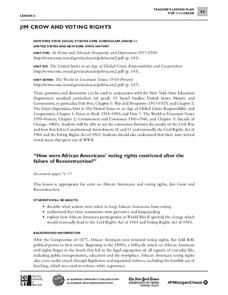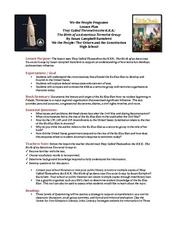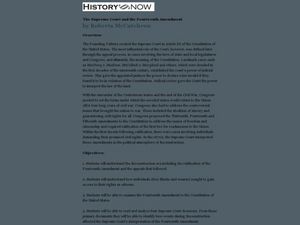University of Arkansas
Promises Denied
"Promises Denied," the second instructional activity in a unit that asks learners to consider the responsibilities individuals have to uphold human rights, looks at documents that illustrate the difficulty the US has had trying to live...
Teaching Tolerance
Slavery as a Form of Racialized Social Control
An engaging lesson delves into the effects of slavery on society. Young historians read text excerpts, complete handouts, and participate in group discussion to understand how slavery was a means to control society and establish a racial...
Teaching Tolerance
Jim Crow as a Form of Racialized Social Control
Just because slavery was illegal doesn't mean it went away ... Jim Crow Laws took its place. An eye-opening lesson focuses on how Jim Crow Laws were used as a form of racial social control against African Americans in the United States....
Curated OER
Rival Plans for Reconstruction
In this Reconstruction worksheet, learners read the provided section summary that detail Reconstruction Plans and respond to 13 short answer questions.
Curated OER
Civil War and Reconstruction Spelling Activity
In this spelling strategies worksheet, students examine the 10 words on the list pertaining to the Civil War and Reconstruction. Students write the words 2 times, cover the words, spell them, and check their work.
Alabama Department of Archives and History
Strange Fruit: Lynching in America
To continue their study of the Civil War, Reconstruction, and the beginning of the civil rights movement, class members watch the YouTube video of Billie Holiday singing "Strange Fruit" as an introduction to an examination of lynching in...
Curated OER
Radical Reconstruction
Students explore the Republican plan for Radical Reconstruction. In this reading comprehension lesson, students use a PowerPoint presentation given by the teacher and multiple texts to answer questions that help them understand why the...
Curated OER
Slavery in the United States: Primary Sources and the Historical Record Lesson
Students analyze primary source documents to determine how life was for slaves. In this slavery lesson, students view online resources from the Library of Congress to analyze and discuss. Students select a final object to analyze and...
City University of New York
Jim Crow and Voting Rights
Class groups examine primary source documents to determine how the voting rights of African Americans were restricted after the failure of Reconstruction, and how African American participation in World War II lead to change.
Curated OER
The Called Themselves the K.K.K.; The Birth of an American Terrorist Group
How did Ku Klux Klan develop and flourish in the US? How did the government respond to acts of terrorism conducted by the KKK following the Civil War? How does the government respond to acts of terrorism today? This resource launches a...
Curated OER
Arkansas Civil War Bandits and Outlaws
Young historians study civilian Arkansas during the Civil War. They look at the many challenges they faced to keep their homes in order while the men were at war. Learners hear stories of bands of outlaws who ravaged the state during...
Humanities Texas
A President's Vision: Abraham Lincoln
Invite your learners to take a close look at Abraham Lincoln's presidency through analysis worksheets of several images and primary documents, presented on an educational poster entirely dedicated to this great United States president.
Curated OER
1856-1865: Abolitionists and the Civil War
Students explore the concept of philanthropy. In this abolition lesson, students watch "Uncle Tom's Cabin" and discuss the philanthropic acts they witnessed in the film. Students also complete an activity that requires them to determine...
Curated OER
African Americans after the Civil War
Students explore the events of Reconstruction after the Civil War. In this US History instructional activity, students complete several activities and worksheets that reinforce challenges and social upheaval experienced in the South...
Curated OER
This Land is my Land-Westward Expansion During Reconstruction
Students analyze policies regarding Native American territories during Westward Expansion. In this Reconstruction lesson, students research primary and secondary sources pertaining to the transfer of Native American land. Students take...
Curated OER
Reconstruction
Learners describe the period of Reconstruction. Then students describe the concept of sharecropping. They complete a vocabulary prediction confirmation activity for the vocabulary words from the passage.
Curated OER
The Reconstruction Period
Young scholars use documents and other resources to evaluate the success or failure of the Reconstruction for giving rights to African Americans. The documents are primary resources with questions included for students to complete.
Curated OER
The Supreme Court and the Fourteenth Amendment
Students examine the ratification of the Fourteenth Amendment. For this Reconstruction Era lesson, students read and analyze 4 Supreme Court decisions regarding the Fourteenth Amendment and determine how the decisions impacted citizen...
Curated OER
US Civil Rights Movement: Beginnings through the 60s
A real find for a U.S. History teacher, this presentation could supplement many class sessions about the Civil Rights Movement. Pictures of events, major figures, and "Whites Only" signs are striking and effective for even your most...
Curated OER
Slave Narratives: Constructing U.S. History Through Analyzing Primary Sources
Learners access oral histories that contain slave narratives from the Library of Congress. They describe the lives of former slaves, sample varied individual experiences and make generalizations about their research in journal entries.
Facing History and Ourselves
Violence and Backlash
Revolution and counterrevolution. Protest and counter-protest. Collaborators and bystanders. The focus of the fifth resource in the Reconstruction Era and Fragility of Democracy series is on the political violence that followed Radical...
Facing History and Ourselves
A Contested History
Memories of and interpretations of history change—that's the key takeaway from a lesson that has young historians compare the story of the Reconstruction Era as told by the historians of the Dunning School to the view of scholars today...
Core Knowledge Foundation
The Civil War
A student reader shares information about the history of slavery, the Civil War, President Abraham Lincoln, women's contributions to the war, the Emancipation Proclamation, and reconstruction.
Digital Public Library of America
Frederick Douglass and Abraham Lincoln
Frederic Douglass and Abraham Lincoln, although dissimilar in their backgrounds, were united in their views about slavery. A set of 14 primary sources permits scholars to examine the views of these two powerful men.

























